Abstract
Strictly anaerobic halophiles, namely fermentative, sulfate-reducing, homoacetogenic, phototrophic, and methanogenic bacteria are involved in the oxidation of organic carbon in hypersaline environments. To date, six anaerobic fermentative genera, containing nine species, have been described. Two of them are homoacetogens. Six species belong to the family Haloanaerobiaceae, as indicated by their unique 16S rRNA oligonucleotide sequences. Desulfohalobium retbaense and Desulfovibrio halophilus represent the only two moderately halophilic sulfate reducers so far reported. Among anoxygenic phototrophic anaerobes, a few purple bacteria with optimal growth at salinities between 6 and 11% NaCl have been isolated from hypersaline habitats. They belong to the genera Rhodospirillum, Chromatium, Thiocapsa, and Ectothiorhodospira. The commonest organisms isolated so far are Chromatium salexigens, Thiocapsa halophila, and Rhodospirillum salinarum. Extremely halophilic purple bacteria have most commonly been isolated from alkaline brines and require about 20 to 25% NaCl for optimal growth. They belong to the family Ectothiorodhospiraceae. Their osmoregulation involves synthesis or uptake of compatible solutes such as glycine-betaine that accumulate in their cytoplasm. The existence of methanogens in hypersaline environments is related to the presence of noncompetitive substrates such as methylamines, which originate mainly from the breakdown of osmoregulatory amines. Methanogenesis probably does not contribute to the mineralization of carbohydrates at NaCl concentrations higher than 15%. Above this concentration, sulfate reduction is probably the main way to oxidize H2 (although at rates too low to use up all the H2 formed) and occupies a terminal function kn the degradation of carbohydrates. Three genera and five species of halophilic methylotrophic methanogens have been reported. A bloom of phototrophic bacteria in the marine salterns of Salins-de-Giraud, located on the Mediterranean French coast in the Rhone Delta, is also described.
Full text
PDF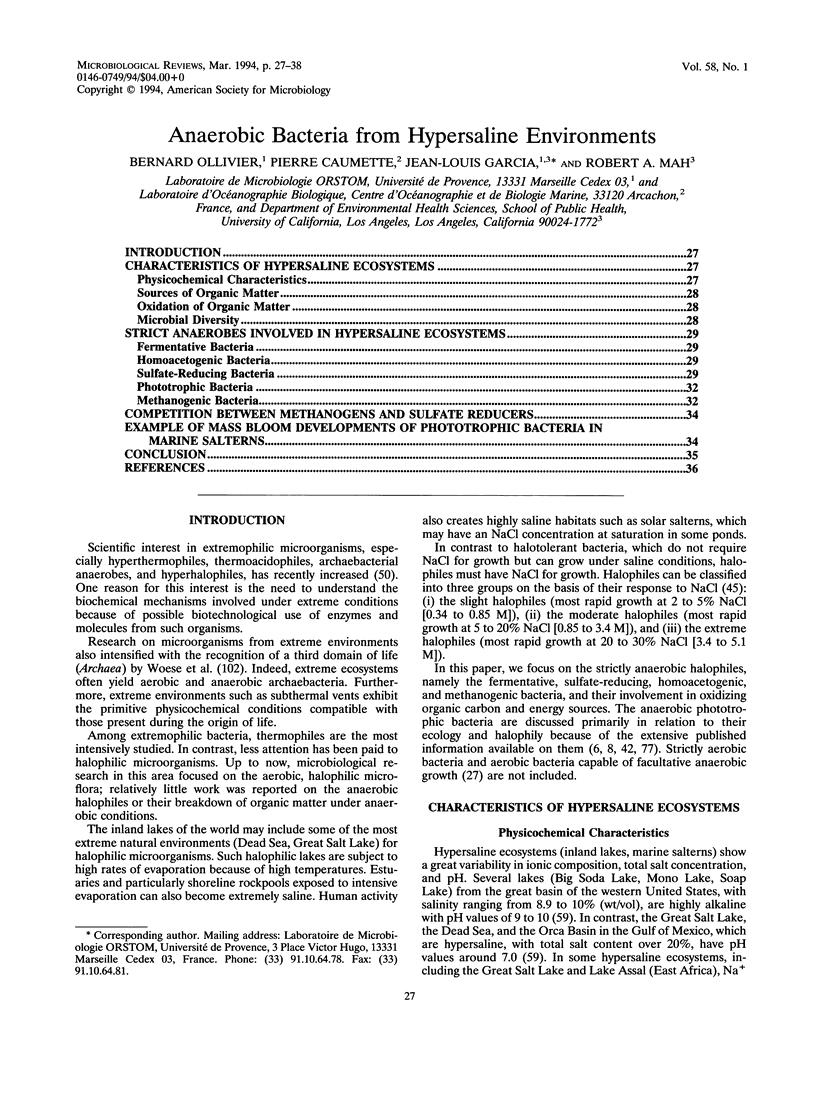
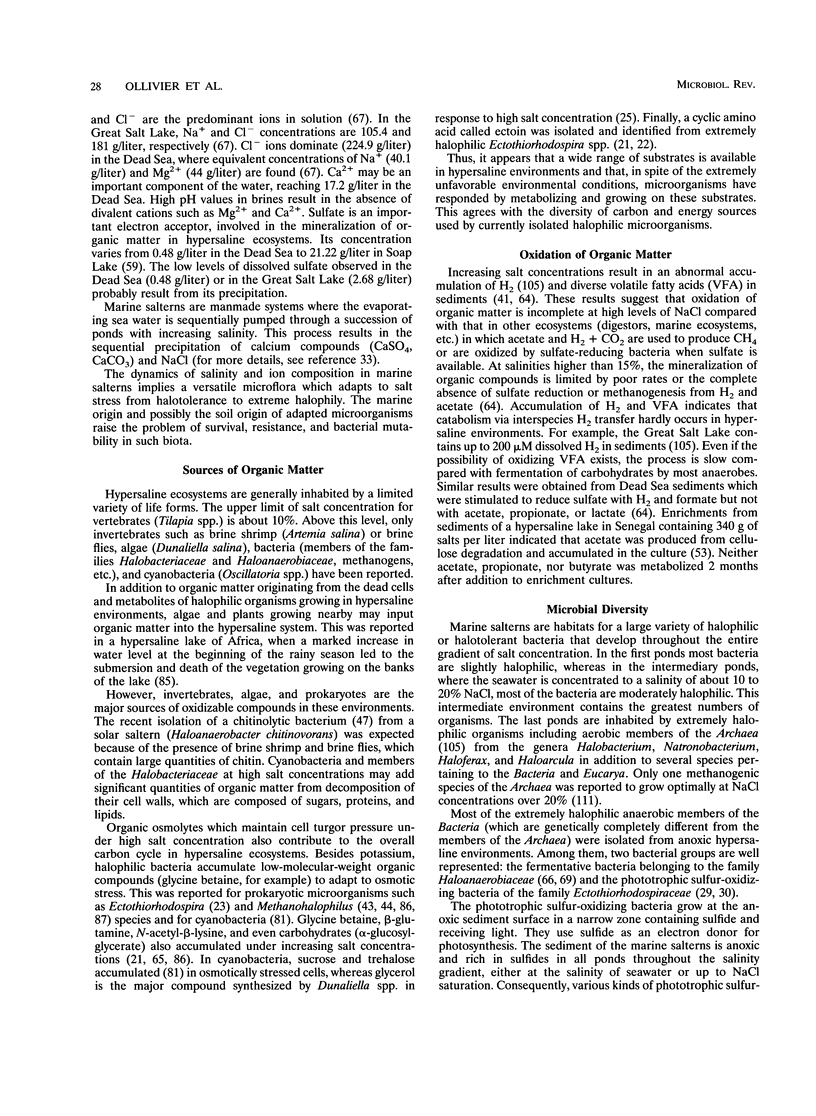
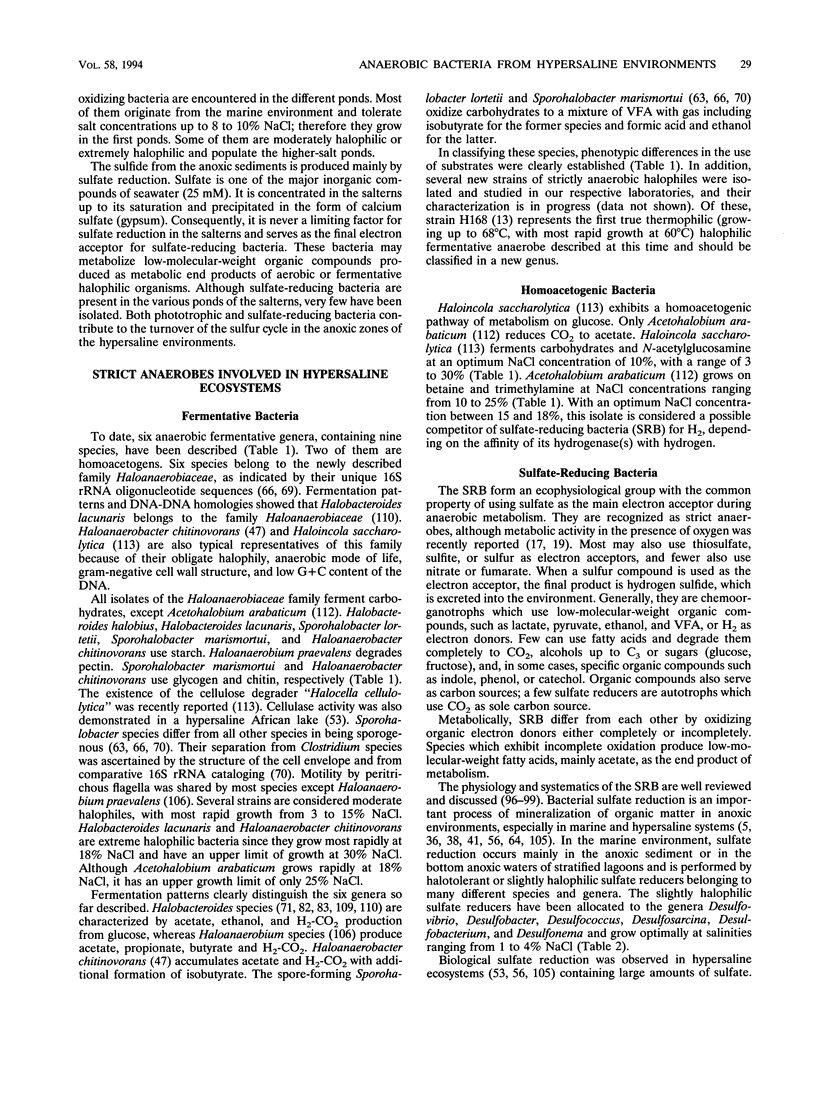
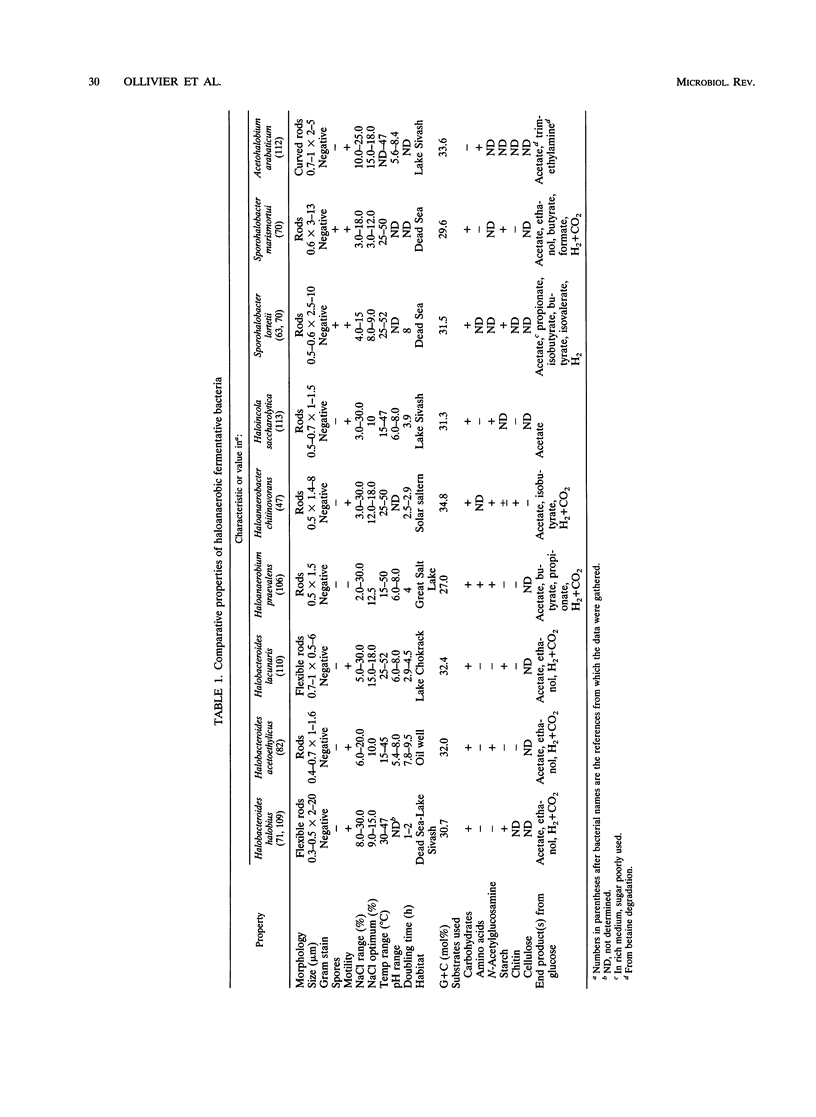
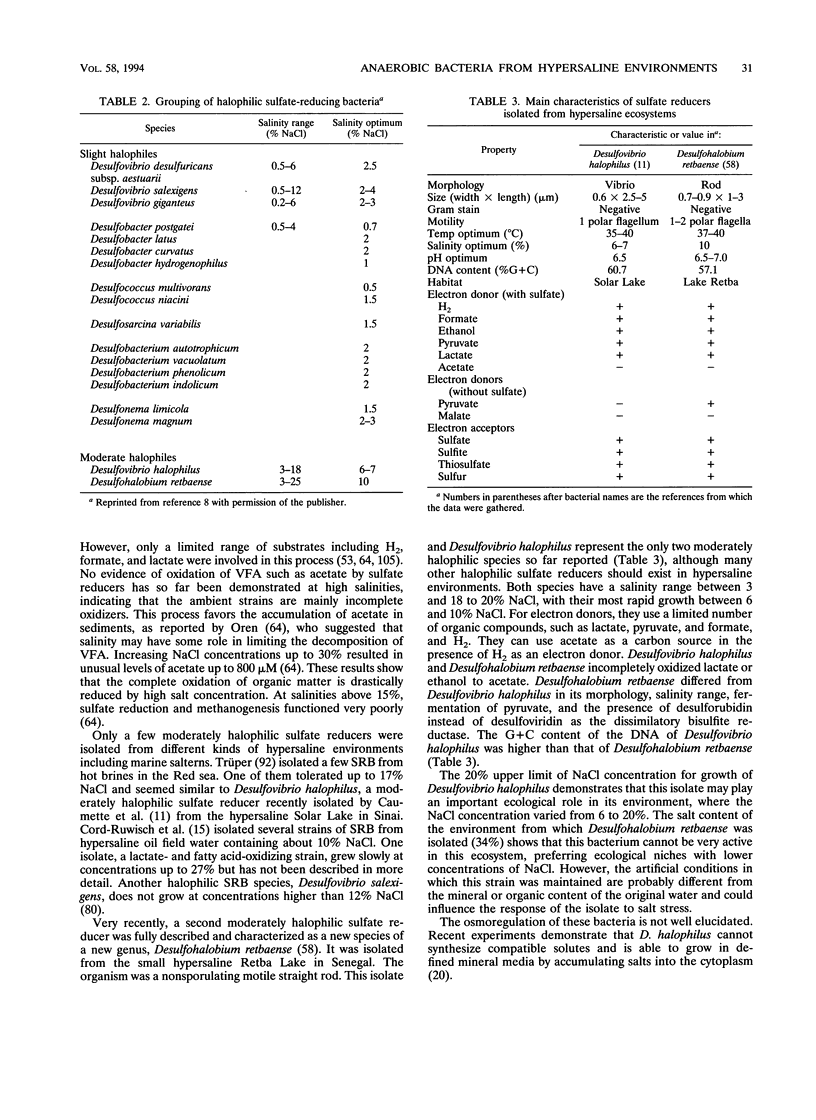
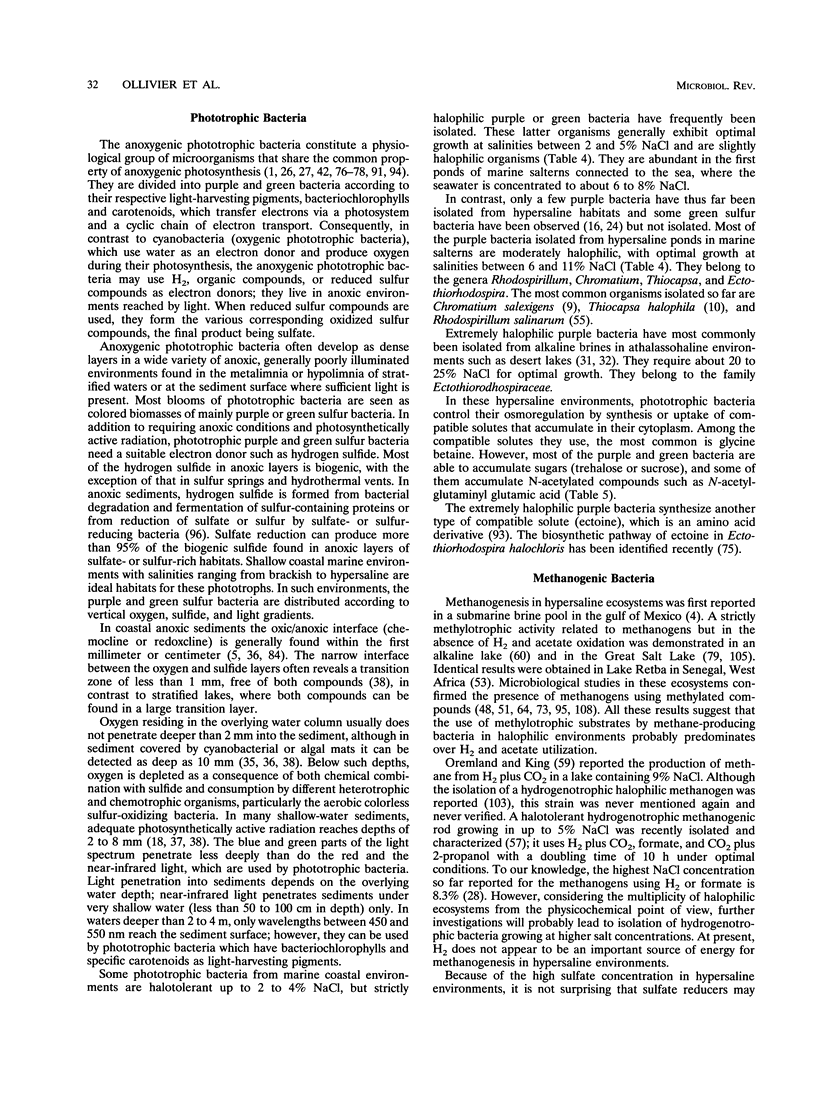
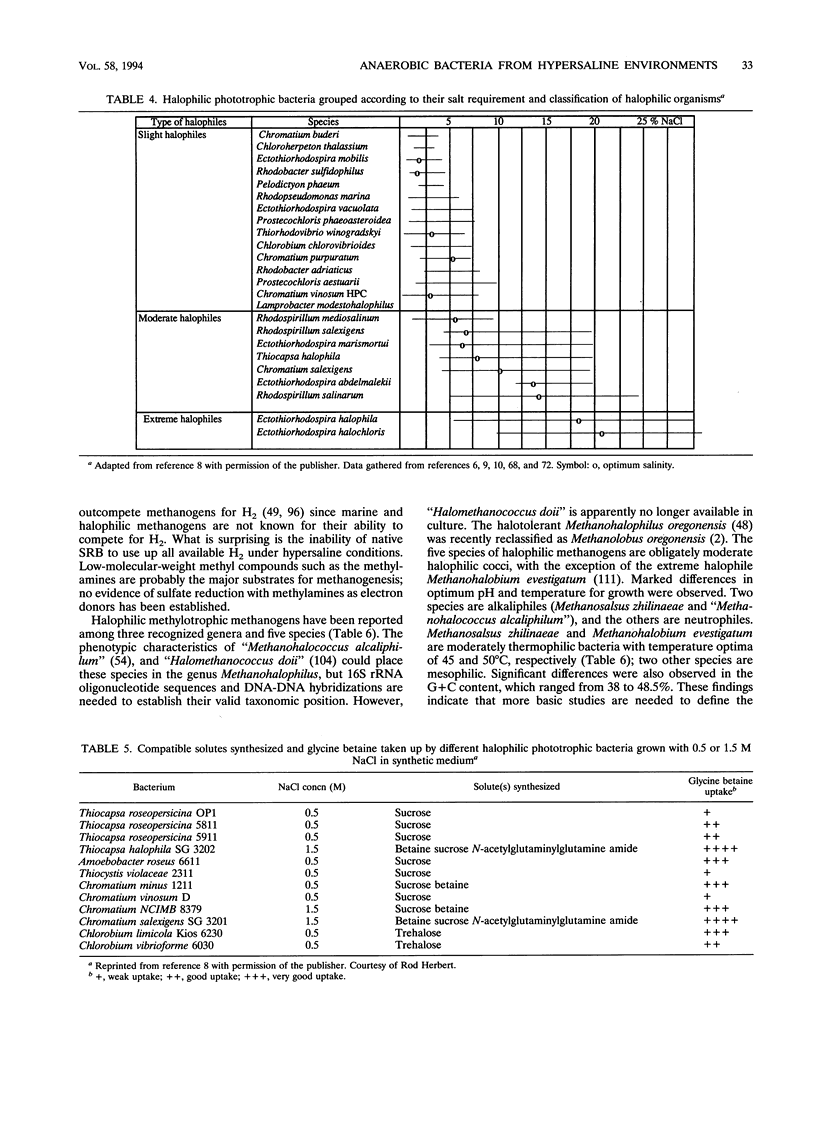
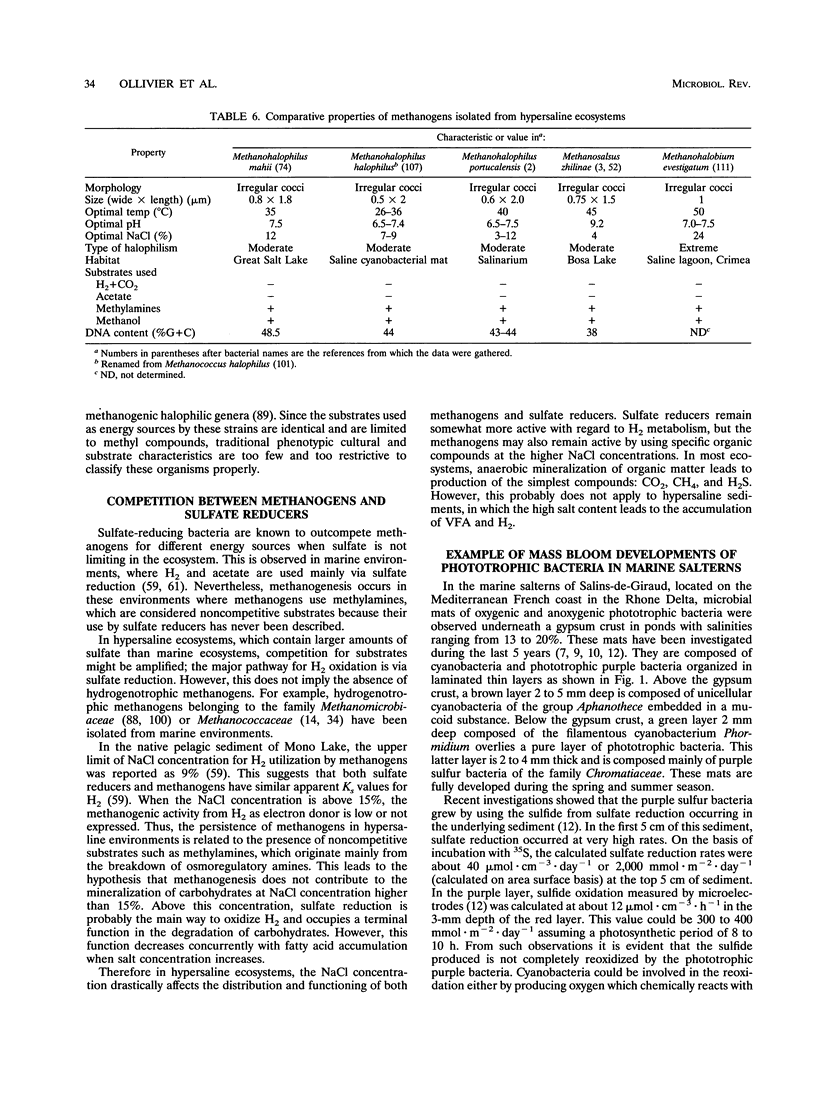
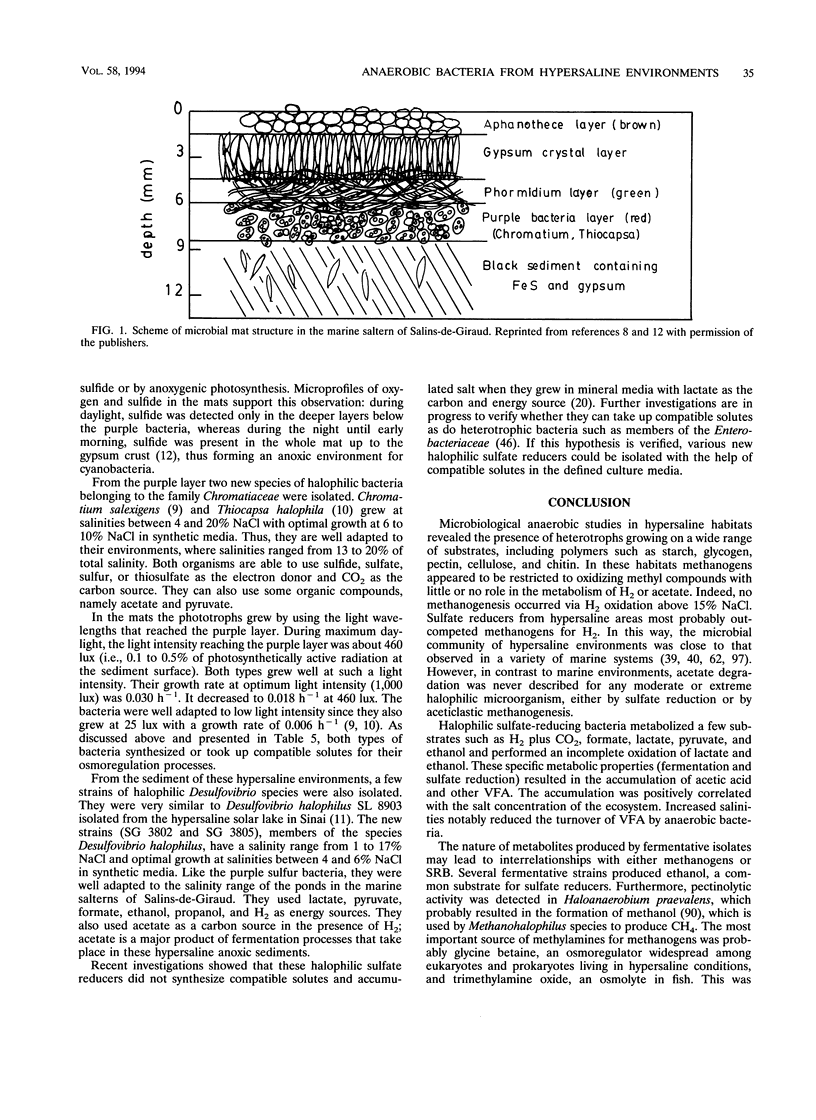
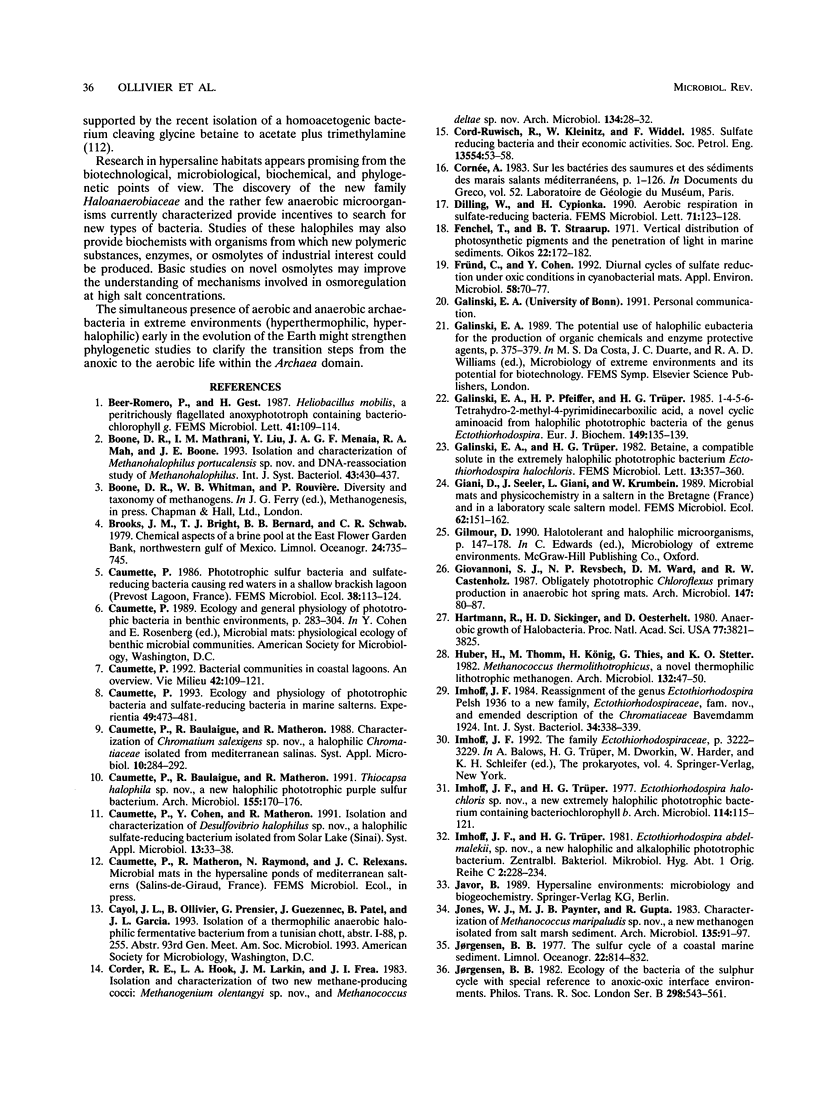
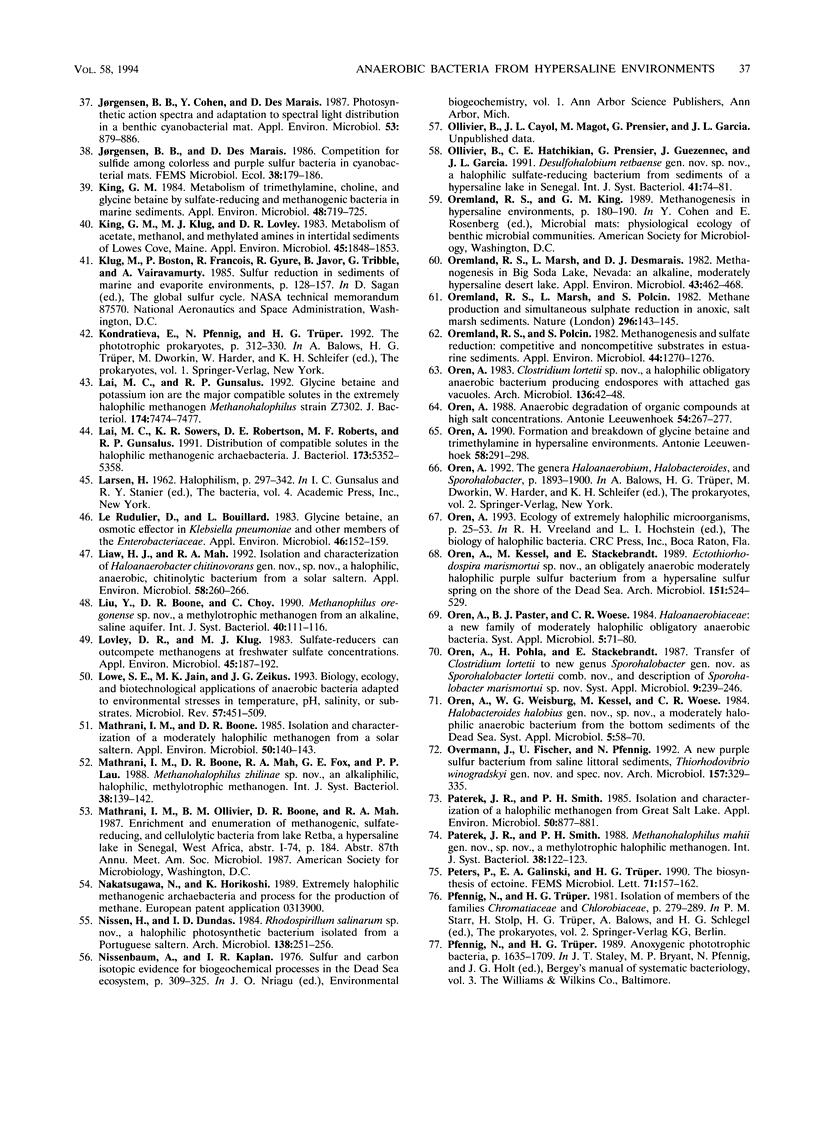
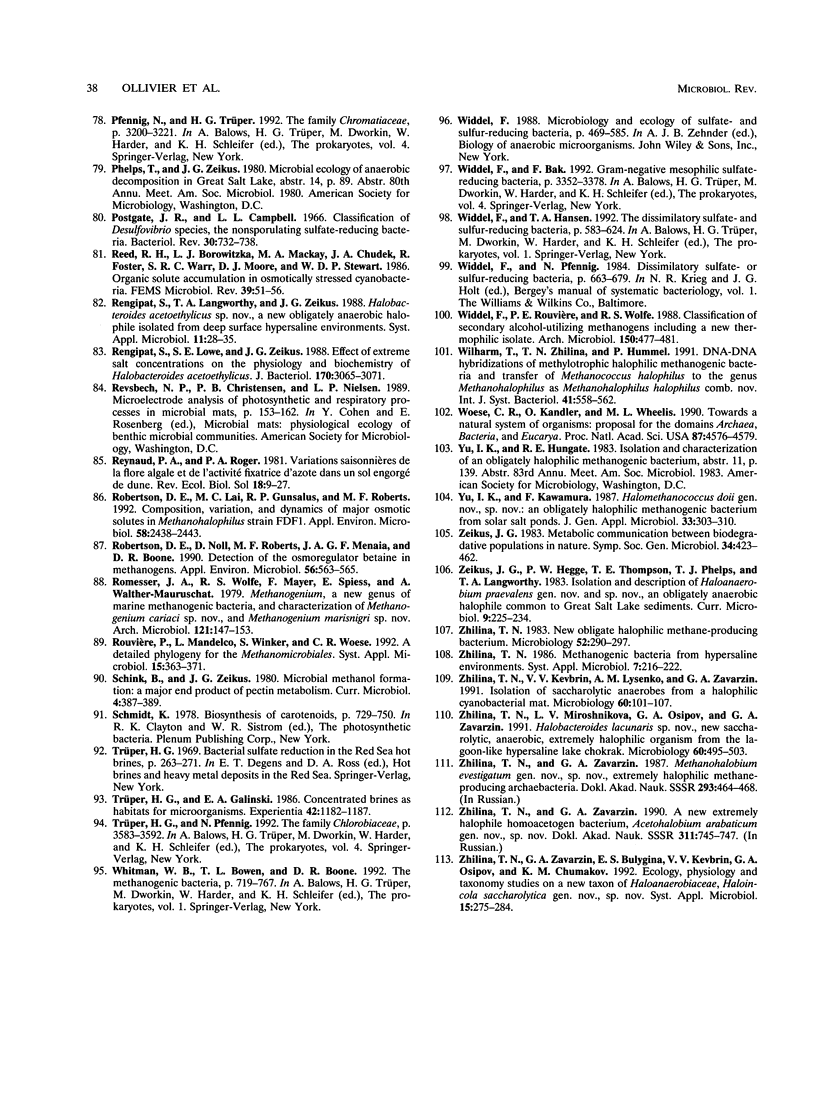
Selected References
These references are in PubMed. This may not be the complete list of references from this article.
- Fründ C., Cohen Y. Diurnal Cycles of Sulfate Reduction under Oxic Conditions in Cyanobacterial Mats. Appl Environ Microbiol. 1992 Jan;58(1):70–77. doi: 10.1128/aem.58.1.70-77.1992. [DOI] [PMC free article] [PubMed] [Google Scholar]
- Galinski E. A., Pfeiffer H. P., Trüper H. G. 1,4,5,6-Tetrahydro-2-methyl-4-pyrimidinecarboxylic acid. A novel cyclic amino acid from halophilic phototrophic bacteria of the genus Ectothiorhodospira. Eur J Biochem. 1985 May 15;149(1):135–139. doi: 10.1111/j.1432-1033.1985.tb08903.x. [DOI] [PubMed] [Google Scholar]
- Hartmann R., Sickinger H. D., Oesterhelt D. Anaerobic growth of halobacteria. Proc Natl Acad Sci U S A. 1980 Jul;77(7):3821–3825. doi: 10.1073/pnas.77.7.3821. [DOI] [PMC free article] [PubMed] [Google Scholar]
- Jorgensen B. B., Cohen Y., Des Marais D. J. Photosynthetic action spectra and adaptation to spectral light distribution in a benthic cyanobacterial mat. Appl Environ Microbiol. 1987 Apr;53(4):879–886. doi: 10.1128/aem.53.4.879-886.1987. [DOI] [PMC free article] [PubMed] [Google Scholar]
- Jorgensen B. B., Des Marais D. J. Competition for sulfide among colorless and purple sulfur bacteria in cyanobacterial mats. FEMS Microbiol Ecol. 1986;38:179–186. doi: 10.1111/j.1574-6968.1986.tb01727.x. [DOI] [PubMed] [Google Scholar]
- Jørgensen B. B. Ecology of the bacteria of the sulphur cycle with special reference to anoxic-oxic interface environments. Philos Trans R Soc Lond B Biol Sci. 1982 Sep 13;298(1093):543–561. doi: 10.1098/rstb.1982.0096. [DOI] [PubMed] [Google Scholar]
- King G. M., Klug M. J., Lovley D. R. Metabolism of acetate, methanol, and methylated amines in intertidal sediments of lowes cove, maine. Appl Environ Microbiol. 1983 Jun;45(6):1848–1853. doi: 10.1128/aem.45.6.1848-1853.1983. [DOI] [PMC free article] [PubMed] [Google Scholar]
- King G. M. Metabolism of trimethylamine, choline, and glycine betaine by sulfate-reducing and methanogenic bacteria in marine sediments. Appl Environ Microbiol. 1984 Oct;48(4):719–725. doi: 10.1128/aem.48.4.719-725.1984. [DOI] [PMC free article] [PubMed] [Google Scholar]
- Lai M. C., Gunsalus R. P. Glycine betaine and potassium ion are the major compatible solutes in the extremely halophilic methanogen Methanohalophilus strain Z7302. J Bacteriol. 1992 Nov;174(22):7474–7477. doi: 10.1128/jb.174.22.7474-7477.1992. [DOI] [PMC free article] [PubMed] [Google Scholar]
- Lai M. C., Sowers K. R., Robertson D. E., Roberts M. F., Gunsalus R. P. Distribution of compatible solutes in the halophilic methanogenic archaebacteria. J Bacteriol. 1991 Sep;173(17):5352–5358. doi: 10.1128/jb.173.17.5352-5358.1991. [DOI] [PMC free article] [PubMed] [Google Scholar]
- Le Rudulier D., Bouillard L. Glycine betaine, an osmotic effector in Klebsiella pneumoniae and other members of the Enterobacteriaceae. Appl Environ Microbiol. 1983 Jul;46(1):152–159. doi: 10.1128/aem.46.1.152-159.1983. [DOI] [PMC free article] [PubMed] [Google Scholar]
- Liaw H. J., Mah R. A. Isolation and Characterization of Haloanaerobacter chitinovorans gen. nov., sp. nov., a Halophilic, Anaerobic, Chitinolytic Bacterium from a Solar Saltern. Appl Environ Microbiol. 1992 Jan;58(1):260–266. doi: 10.1128/aem.58.1.260-266.1992. [DOI] [PMC free article] [PubMed] [Google Scholar]
- Lovley D. R., Klug M. J. Sulfate reducers can outcompete methanogens at freshwater sulfate concentrations. Appl Environ Microbiol. 1983 Jan;45(1):187–192. doi: 10.1128/aem.45.1.187-192.1983. [DOI] [PMC free article] [PubMed] [Google Scholar]
- Lowe S. E., Jain M. K., Zeikus J. G. Biology, ecology, and biotechnological applications of anaerobic bacteria adapted to environmental stresses in temperature, pH, salinity, or substrates. Microbiol Rev. 1993 Jun;57(2):451–509. doi: 10.1128/mr.57.2.451-509.1993. [DOI] [PMC free article] [PubMed] [Google Scholar]
- Mathrani I. M., Boone D. R. Isolation and characterization of a moderately halophilic methanogen from a solar saltern. Appl Environ Microbiol. 1985 Jul;50(1):140–143. doi: 10.1128/aem.50.1.140-143.1985. [DOI] [PMC free article] [PubMed] [Google Scholar]
- Mathrani I. M., Boone D. R., Mah R. A., Fox G. E., Lau P. P. Methanohalophilus zhilinae sp. nov., an alkaliphilic, halophilic, methylotrophic methanogen. Int J Syst Bacteriol. 1988 Apr;38(2):139–142. doi: 10.1099/00207713-38-2-139. [DOI] [PubMed] [Google Scholar]
- Oremland R. S., Marsh L., Desmarais D. J. Methanogenesis in big soda lake, nevada: an alkaline, moderately hypersaline desert lake. Appl Environ Microbiol. 1982 Feb;43(2):462–468. doi: 10.1128/aem.43.2.462-468.1982. [DOI] [PMC free article] [PubMed] [Google Scholar]
- Oremland R. S., Polcin S. Methanogenesis and sulfate reduction: competitive and noncompetitive substrates in estuarine sediments. Appl Environ Microbiol. 1982 Dec;44(6):1270–1276. doi: 10.1128/aem.44.6.1270-1276.1982. [DOI] [PMC free article] [PubMed] [Google Scholar]
- Oren A. Anaerobic degradation of organic compounds at high salt concentrations. Antonie Van Leeuwenhoek. 1988;54(3):267–277. doi: 10.1007/BF00443585. [DOI] [PubMed] [Google Scholar]
- Oren A. Formation and breakdown of glycine betaine and trimethylamine in hypersaline environments. Antonie Van Leeuwenhoek. 1990 Nov;58(4):291–298. doi: 10.1007/BF00399342. [DOI] [PubMed] [Google Scholar]
- Paterek J. R., Smith P. H. Isolation and characterization of a halophilic methanogen from great salt lake. Appl Environ Microbiol. 1985 Oct;50(4):877–881. doi: 10.1128/aem.50.4.877-881.1985. [DOI] [PMC free article] [PubMed] [Google Scholar]
- Postgate J. R., Campbell L. L. Classification of Desulfovibrio species, the nonsporulating sulfate-reducing bacteria. Bacteriol Rev. 1966 Dec;30(4):732–738. doi: 10.1128/br.30.4.732-738.1966. [DOI] [PMC free article] [PubMed] [Google Scholar]
- Rengpipat S., Lowe S. E., Zeikus J. G. Effect of extreme salt concentrations on the physiology and biochemistry of Halobacteroides acetoethylicus. J Bacteriol. 1988 Jul;170(7):3065–3071. doi: 10.1128/jb.170.7.3065-3071.1988. [DOI] [PMC free article] [PubMed] [Google Scholar]
- Robertson D. E., Lai M. C., Gunsalus R. P., Roberts M. F. Composition, Variation, and Dynamics of Major Osmotic Solutes in Methanohalophilus Strain FDF1. Appl Environ Microbiol. 1992 Aug;58(8):2438–2443. doi: 10.1128/aem.58.8.2438-2443.1992. [DOI] [PMC free article] [PubMed] [Google Scholar]
- Robertson D. E., Noll D., Roberts M. F., Menaia J. A., Boone D. R. Detection of the osmoregulator betaine in methanogens. Appl Environ Microbiol. 1990 Feb;56(2):563–565. doi: 10.1128/aem.56.2.563-565.1990. [DOI] [PMC free article] [PubMed] [Google Scholar]
- Rouvière P., Mandelco L., Winker S., Woese C. R. A detailed phylogeny for the Methanomicrobiales. Syst Appl Microbiol. 1992 Aug;15(3):363–371. doi: 10.1016/S0723-2020(11)80209-2. [DOI] [PubMed] [Google Scholar]
- Woese C. R., Kandler O., Wheelis M. L. Towards a natural system of organisms: proposal for the domains Archaea, Bacteria, and Eucarya. Proc Natl Acad Sci U S A. 1990 Jun;87(12):4576–4579. doi: 10.1073/pnas.87.12.4576. [DOI] [PMC free article] [PubMed] [Google Scholar]


